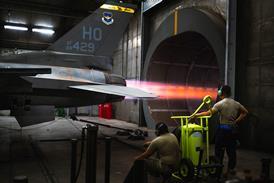The US Navy is warning that it faces ending production of the Northrop Grumman E-2C airborne early warning and control aircraft unless follow-on funding can be secured within the next year to order additional improved Hawkeye 2000s, as well as to start full scale development of future sensors and avionics.
Northrop Grumman is building 21 new Hawkeye 2000s under a multi-year contract awarded in 1999, with the first due for delivery in November. Production will begin to slow within three years with the final aircraft due for completion by early 2006.
"We're coming up to a decision point on the Fiscal Year 2003 bill where the navy is going to have to make a commitment to build more E-2Cs or get out of the business. The line will start to shut down in 2003 unless we build more and tie to this is the Radar Modernisation Programme," says Capt Lee Lilly, USN E-2C/C-2A programme manager.
The USN has around 12 months to make its case for extending the E-2C line and starting RMP engineering and manufacturing development (EMD), before funding requests are submitted in early next year for 2003. The navy had hoped to start RMP work in FY02.
A technology demonstration of the follow-on APS-XX radar using a Lockheed Martin EC-130V testbed will start next year and is funded to 2004. EMD money will prevent the disbandment of development teams, says Lilly.
An RMP-equipped Hawkeye could be fielded by 2007 if EMD starts in 2003, but the USN will have to acquire 12 Hawkeye 2000s to fill three years production. The alternative is the more costly option of shutting down and restarting production, or the even more expensive proposition of switching to a new platform in 2012.
Also, the USN has considered updating its 54 Group 2 (earlier) standard E-2Cs to Hawkeye 2000s, but this presents an even bigger challenge when incorporating the follow-on radar. RMP can be retrofitted but only with drastic modifications, says Lilly.
Source: Flight International























